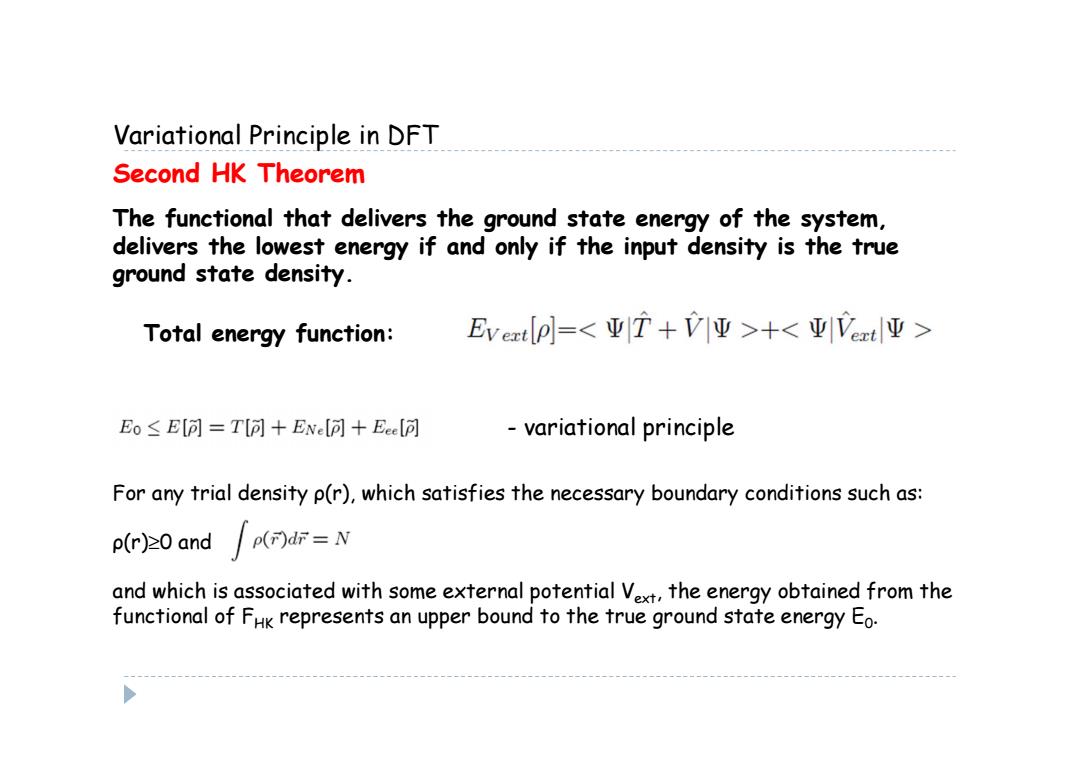
Variational Principle in DFT Second HK Theorem The functional that delivers the ground state energy of the system, delivers the lowest energy if and only if the input density is the true ground state density. Total energy function: Evertlp]=-<亚T+亚>+<eat亚> Eo≤E[时=T[时+Ewe[问+Eee variational principle For any trial density p(r),which satisfies the necessary boundary conditions such as: p(r)>0 and p(F)dF=N and which is associated with some external potential Vext,the energy obtained from the functional of FHK represents an upper bound to the true ground state energy Eo
Variational Principle in DFT Second HK Theorem The functional that delivers the ground state energy of the system, delivers the lowest energy if and only if the input density is the true ground state density. - variational principle For any trial density ρ(r), which satisfies the necessary boundary conditions such as: ρ(r)≥0 and and which is associated with some external potential Vext, the energy obtained from the functional of FHK represents an upper bound to the true ground state energy E0. Total energy function:

First attempt:Thomas-Fermi model (1927) TrlbI-83m1p9as L.H.Thomas,Proc.Camb.Phil.Soc.,23,542-548 (1927) E.Fermi,Rend.Acad.,Lincei,6,602-607(1927) 5m61-83m3pns-jar+.5打iaa斯时 Problem in TF approximation:ignore correlation,and use local density approximation Kohn and Sham (1965) T[p] -kinetic energy of the system Kohn and Sham proposed to calculate the exact kinetic energy of a non-interacting system with the same density as for the real interacting system. =2gg Tks kinetic energy of a fictitious non-interacting system of the same density p(r) are the orbitals for the non-interacting system (KS orbitals) Tks is not equal to the true kinetic energy of the system,but contains the major fraction of it T=Tks+(T-Tks) Hohenberg-Kohn (1964)and Kohn-Sham (1965)---Modern DFT
First attempt: Thomas-Fermi model (1927) = (3 π ) ρ ( r)d r 10 3 T [ρ ( r)] 2 2/3 5/3 TF 1 2 12 2 2/3 5/3 1 2 TF d r d r r ρ ( r ) ρ ( r ) 2 1 d r r ρ ( r ) (3 π ) ρ ( r)d r Z 10 3 E [ ρ ( r)] = − + L.H. Thomas, Proc. Camb. Phil. Soc., 23, 542-548 (1927) E. Fermi, Rend. Acad., Lincei, 6, 602-607 (1927) Problem in TF approximation: ignore correlation, and use local density approximation Kohn and Sham (1965) T[ ρ] – kinetic energy of the system Kohn and Sham proposed to calculate the exact kinetic energy of a non-interacting system with the same density as for the real interacting system. = = − ∇ N i 1 i 2 KS Ψi Ψ 2 1 T TKS – kinetic energy of a fictitious non-interacting system of the same density ρ(r) Ψi - are the orbitals for the non-interacting system (KS orbitals) Tks is not equal to the true kinetic energy of the system, but contains the major fraction of it T = Tks + (T-Tks ) Hohenberg-Kohn (1964) and Kohn-Sham (1965) ---Modern DFT